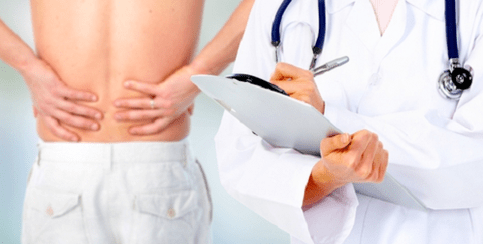Sudden, acute, aching or dull pain that radiates down the leg, low back pain, whose cause cannot be immediately identified, may indicate the development of various diseases. Only an experienced doctor can accurately understand the causes of the pain syndrome, having studied the clinical picture, patient complaints, as well as the results of ultrasound studies and analysis, X-radiography or MRI. But often, even before going to the doctor, a person wants to know in advance what his condition is related to.

The main cause of low back pain
First of all, all the causes of back pain can be divided into two main categories:
- Primary (pain precisely related to pathology of the spine, discs, muscle tissue or joints).
- Secondary (pain occurs with pathology of internal organs and is given to the lower back, as well as due to infectious diseases in the body, the development of tumors).
The main cause of back pain
Today, bipedalism is called the cause of all spinal problems. The load on the spine increases sharply with a straight posture of the body, especially the lower - lumbar, wears out faster.
The main causes of back pain are as follows:
- Lumbar spine tumor. The degenerative changes of the spine cause acute pain, inflammation, swelling in the damaged area, and difficulty in movement. Characteristic changes in the cartilage tissue of the discs and vertebral bodies often cause nerve compression, manifesting as acute pain.
- Osteoarthritis of the vertebrae. This pathology affects joint tissue in the region of the spine. In addition to pain in the joints, people with spondylosis can experience severe stiffness in movement when unable to straighten or turn.
Low back pain caused by osteonecrosis or spondylolisthesis requires urgent, immediate medical attention and, of course, immediate treatment.
Secondary low back pain
A large number of diseases that are not related to the pathological process of the spine can cause unpleasant pain in the back.
There are secondary causes of lower back pain such as:
- curvature of the spine (scoliosis, curvature, etc. );
- infections of various origins affecting the intervertebral disc (tuberculosis, etc. );
- urinary tract infections and the consequences of influenza;
- inflammatory processes in the genital area;
- diseases of the gastrointestinal tract (appendicitis, pancreatitis, cholecystitis, colic);
- kidney disease;
- cancer localized in the peri-lumbar region;
- excess weight;
- osteoporosis, acute rheumatism, chronic arthritis;
- standing or sitting for a long time;
- muscle spasms;
- nervous tension, stress.
Diseases of internal organs have their own vivid symptoms, reflected only in the lower back.
Causes of low back pain in women and men
The structure of the female body easily leads to the appearance of heaviness and pain in the lower back. This is due to the hormonal background: the menstrual cycle, menopause and pregnancy affect the lumbar region, since the reproductive organs are located in the vicinity. Gynecological diseases (inflammation of the appendages and uterus) cause low back pain in women.
Similarly, in men, prostatitis and epididymitis also cause pain. It happens that men experience periodic back pain when working continuously in cold weather in drafts, or if the job involves lifting weights. Such causes of back pain require preventive measures: you need to warm your back and wear a special corset.
Mechanical clamp
Personally, I'd like to refer to times as muscle spasms, which are often the cause of lower back pain. A constant lack of physical activity leads to weak back muscles that are unable to withstand prolonged or increased loads. As a result, working on your feet or in an immobile sitting position will overstress your back muscles and cause pain.
Stress has a similar effect when muscle tension is triggered by feelings of fear or anger. This is followed by spasms and pain, if not eliminated in time.
Concurrent symptoms
Low back pain, caused by damage to the spine, is often accompanied by the following symptoms:
- discomfort can spread not only to the back, but also to the buttocks and lower extremities;
- movement may be very difficult or completely impossible;
- The affected area is often inflamed and swollen.
For any of these symptoms, you should seek medical help from a neurologist. If other symptoms are present, it is better to contact a specialist, who will determine the cause of your back pain and then refer you to a specialist or prescribe treatment.












































